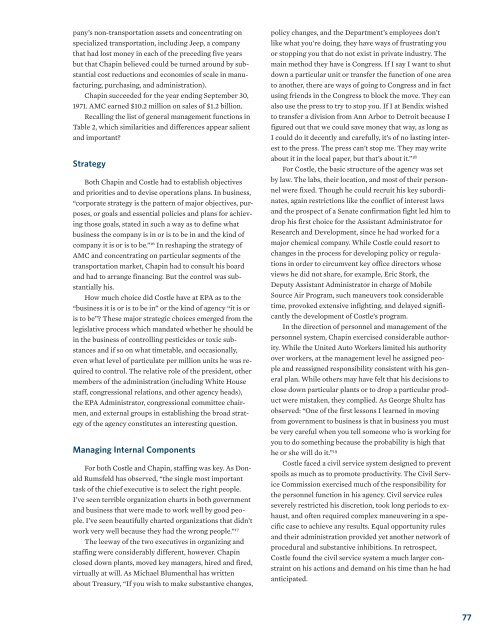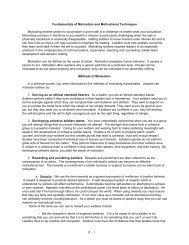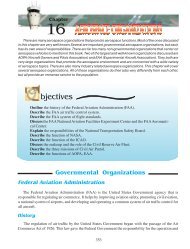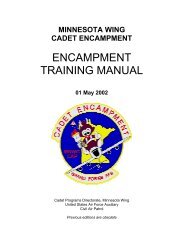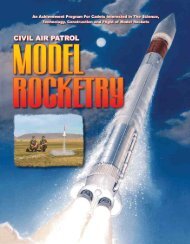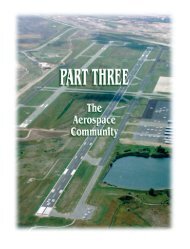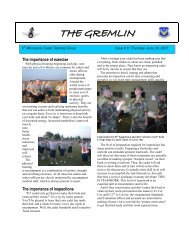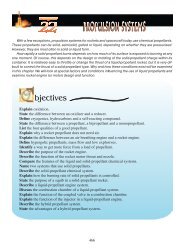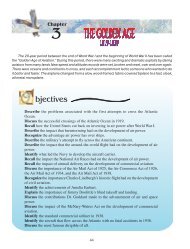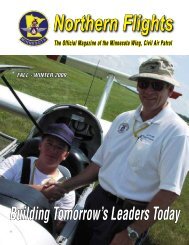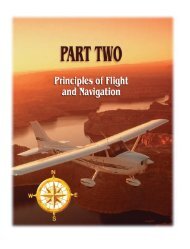islative charter – the Clean <strong>Air</strong> Act and the Clean WaterAct – was being rewritten as he took office; the pesticidesprogram was up for reauthorization also in 1977).• Establishing EPA’s role in the Carter Administration(aware that the Administration would face hard tradeoffsbetween the environment and energy, energy regulationsand the economy, EPA regulations of toxic substances andthe regulations of FDA, CSPS, and OSHA. Costle identifiedthe need to build relations with the other key playersand to enhance EPA’s standing).• Building ties to constituent groups (both because oftheir role in legislating the agency’s mandate and in successfulimplementation of EPA’s programs).• Making specific policy decisions (for example,whether to grant or deny a permit for the Seabrook NuclearGenerating Plant cooling system. Or how the ToxicSubstance Control Act, enacted in October 1976, would beimplemented; this act gave EPA new responsibilities forregulating the manufacture, distribution, and use ofchemical substances so as to prevent unreasonable risksto health and the environment. Whether EPA would requirechemical manufacturers to provide some minimuminformation on various substances, or require muchstricter reporting requirements for the 1,000 chemicalsubstances already known to be hazardous, or requirecompanies to report all chemicals, and on what timetable,had to be decided and the regulations issued).• Rationalizing the internal organization of the agency(EPA’s extreme decentralization to the regions and itslimited technical expertise).No easy job.ROY CHAPIN AND AMERICAN MO<strong>TO</strong>RS,JANUARY 1967In January 1967, in an atmosphere of crisis, RoyChapin was appointed Chairman and Chief Executive Officerof American Motors (and William Luneburg, Presidentand Chief Operating Officer). In the four previousyears, AMC unit sales had fallen 37 percent and marketshare from over 6 percent to under 3 percent. Dollar volumein 1967 was off 42 percent from the all-time high of1963 and earnings showed a net loss of $76 million onsales of $656 million. Columnists began writing obituariesfor AMC. Newsweek characterized AMC as “a flabbydispirited company, a product solid enough but styledwith about as much flair as corrective shoes, and a publicimage that melted down to one unshakable label: loser.”Said Chapin, “We were driving with one foot on the acceleratorand one foot on the brake. We didn’t knowwhere…we were.”Chapin announced to his stockholders at the outsetthat “we plan to direct ourselves most specifically tothose areas of the market where we can be fully effective.We are not going to attempt to be all things to all people,but to concentrate on those areas of consumer needs wecan meet better than anyone else.” As he recalled, “Therewere problems early in 1967 which demanded immediateattention, and which accounted for much of our time forseveral months. Nevertheless, we began planning beyondthem, establishing objectives, programs and timetablesthrough 1972. Whatever happened in the short run, wehad to prove ourselves in the marketplace in the longrun.”Chapin’s immediate problems were five:• The company was virtually out of cash and an immediatesupplemental bank loan of $20 million was essential.• Car inventories – company owned and dealer owned– had reached unprecedented levels. The solution to thisglut took five months and could be accomplished only bya series of plant shutdowns in January 1967.• Sales of the Rambler American series had stagnatedand inventories were accumulating: a dramatic merchandisingmove was concocted and implemented in February,dropping the price tag on the American to a position midwaybetween the VW and competitive smaller U.S. compacts,by both cutting the price to dealers and trimmingdealer discounts from 21 percent to 17 percent.• Administrative and commercial expenses were judgedtoo high and thus a vigorous cost reduction program wasinitiated that trimmed $15 million during the first year.Manufacturing and purchasing costs were also trimmedsignificantly to approach the most effective levels in theindustry.• The company’s public image had deteriorated: thepress was pessimistic and much of the financial communityhad written it off. To counteract this, numerous formaland informal meetings were held with bankers,investment firms, government officials, and the press.As Chapin recalls, “With the immediate fires put out,we could put in place the pieces of a corporate growthplan – a definition of a way of life in the auto industry forAmerican Motors. We felt that our reason for being,which would enable us not just to survive but to grow, layin bringing a different approach to the auto market – inpicking our spots and then being innovative and aggressive.”The new corporate growth plan included a dramaticchange in the approach to the market to establish a“youthful image” for the company (by bringing out newsporty models like the Javelin and by entering the racingfield), “changing the product line from one end to theother” by 1972, acquiring Kaiser Jeep (selling the com-76
pany’s non-transportation assets and concentrating onspecialized transportation, including Jeep, a companythat had lost money in each of the preceding five yearsbut that Chapin believed could be turned around by substantialcost reductions and economies of scale in manufacturing,purchasing, and administration).Chapin succeeded for the year ending September 30,1971. AMC earned $10.2 million on sales of $1.2 billion.Recalling the list of general management functions inTable 2, which similarities and differences appear salientand important?StrategyBoth Chapin and Costle had to establish objectivesand priorities and to devise operations plans. In business,“corporate strategy is the pattern of major objectives, purposes,or goals and essential policies and plans for achievingthose goals, stated in such a way as to define whatbusiness the company is in or is to be in and the kind ofcompany it is or is to be.” 16 In reshaping the strategy ofAMC and concentrating on particular segments of thetransportation market, Chapin had to consult his boardand had to arrange financing. But the control was substantiallyhis.How much choice did Costle have at EPA as to the“business it is or is to be in” or the kind of agency “it is oris to be”? These major strategic choices emerged from thelegislative process which mandated whether he should bein the business of controlling pesticides or toxic substancesand if so on what timetable, and occasionally,even what level of particulate per million units he was requiredto control. The relative role of the president, othermembers of the administration (including White Housestaff, congressional relations, and other agency heads),the EPA Administrator, congressional committee chairmen,and external groups in establishing the broad strategyof the agency constitutes an interesting question.Managing Internal ComponentsFor both Costle and Chapin, staffing was key. As DonaldRumsfeld has observed, “the single most importanttask of the chief executive is to select the right people.I’ve seen terrible organization charts in both governmentand business that were made to work well by good people.I’ve seen beautifully charted organizations that didn’twork very well because they had the wrong people.” 17The leeway of the two executives in organizing andstaffing were considerably different, however. Chapinclosed down plants, moved key managers, hired and fired,virtually at will. As Michael Blumenthal has writtenabout Treasury, “If you wish to make substantive changes,policy changes, and the Department’s employees don’tlike what you’re doing, they have ways of frustrating youor stopping you that do not exist in private industry. Themain method they have is Congress. If I say I want to shutdown a particular unit or transfer the function of one areato another, there are ways of going to Congress and in factusing friends in the Congress to block the move. They canalso use the press to try to stop you. If I at Bendix wishedto transfer a division from Ann Arbor to Detroit because Ifigured out that we could save money that way, as long asI could do it decently and carefully, it’s of no lasting interestto the press. The press can’t stop me. They may writeabout it in the local paper, but that’s about it.” 18For Costle, the basic structure of the agency was setby law. The labs, their location, and most of their personnelwere fixed. Though he could recruit his key subordinates,again restrictions like the conflict of interest lawsand the prospect of a Senate confirmation fight led him todrop his first choice for the Assistant Administrator forResearch and Development, since he had worked for amajor chemical company. While Costle could resort tochanges in the process for developing policy or regulationsin order to circumvent key office directors whoseviews he did not share, for example, Eric Stork, theDeputy Assistant Administrator in charge of MobileSource <strong>Air</strong> Program, such maneuvers took considerabletime, provoked extensive infighting, and delayed significantlythe development of Costle’s program.In the direction of personnel and management of thepersonnel system, Chapin exercised considerable authority.While the United Auto Workers limited his authorityover workers, at the management level he assigned peopleand reassigned responsibility consistent with his generalplan. While others may have felt that his decisions toclose down particular plants or to drop a particular productwere mistaken, they complied. As George Shultz hasobserved: “One of the first lessons I learned in movingfrom government to business is that in business you mustbe very careful when you tell someone who is working foryou to do something because the probability is high thathe or she will do it.” 19Costle faced a civil service system designed to preventspoils as much as to promote productivity. The <strong>Civil</strong> ServiceCommission exercised much of the responsibility forthe personnel function in his agency. <strong>Civil</strong> service rulesseverely restricted his discretion, took long periods to exhaust,and often required complex maneuvering in a specificcase to achieve any results. Equal opportunity rulesand their administration provided yet another network ofprocedural and substantive inhibitions. In retrospect,Costle found the civil service system a much larger constrainton his actions and demand on his time than he hadanticipated.77
- Page 1 and 2:
VOLUME FOUR STRATEGIC PERSPECTIVESL
- Page 3 and 4:
VOLUME FOUR STRATEGIC PERSPECTIVESL
- Page 5 and 6:
VOLUME FOUR STRATEGIC PERSPECTIVESL
- Page 7:
VOLUME FOUR STRATEGIC PERSPECTIVESL
- Page 10 and 11:
12CHAPTER 12INTRODUCTION TO STRATEG
- Page 12 and 13:
12.1 Strategic Leadership: Defining
- Page 14 and 15:
mandates or resolutions that would
- Page 16 and 17:
and ambiguity, aspiring strategic l
- Page 18 and 19:
12.2 National Security StrategyThe
- Page 20 and 21:
within our borders has always been
- Page 22 and 23:
front common challenges like violen
- Page 24 and 25:
and our strategy, not sector earmar
- Page 26 and 27:
thinking about organizations. She m
- Page 28 and 29: A systemic approach to failure is m
- Page 30 and 31: The late W. T. Grant Company is a r
- Page 32 and 33: the resources - setting the directi
- Page 34 and 35: focal point for describing and inte
- Page 36 and 37: Consequently, we do not restrict th
- Page 38 and 39: paragraphs, Web pages, then edit an
- Page 40 and 41: Web, can be viewed as a CS attempt
- Page 42 and 43: How to evaluate users and contribut
- Page 44 and 45: 13CHAPTER 13LEADING PUBLIC &VOLUNTE
- Page 46 and 47: 13.1 Leadership for Volunteers:The
- Page 48 and 49: 13.2 Take Root: Volunteer Managemen
- Page 50 and 51: QualificationsClearly list educatio
- Page 52 and 53: and effectively track their volunte
- Page 54 and 55: • Understand rules for recognitio
- Page 56 and 57: • Send a birthday card.• Submit
- Page 58 and 59: and tested more than six decades af
- Page 60 and 61: specific interests of the donors, v
- Page 62 and 63: tain) tax-exempt status from the In
- Page 64 and 65: Smucker, 1999).The Internal Revenue
- Page 66 and 67: culture is necessary to ensure the
- Page 68 and 69: 13.4 The New Look of TransparencyBy
- Page 70 and 71: ees for a couple of reasons: One, i
- Page 72 and 73: 13.5 Public and Private Management:
- Page 74 and 75: TABLE 1:FUNCTIONS OF GENERAL MANAGE
- Page 76 and 77: 3. Career System. The model corpora
- Page 80 and 81: In controlling performance, Chapin
- Page 82 and 83: 14CHAPTER 14AIRPOWER ASSTRATEGIC LA
- Page 84 and 85: 14.1 Strategic Air Power: Fulfillme
- Page 86 and 87: carry it out. Their daylight raids
- Page 88 and 89: you did not rely on strategic bombi
- Page 90 and 91: 14.2 Warden and the Air Corps Tacti
- Page 92 and 93: ecomes one of applying sufficient i
- Page 94 and 95: tification, and a Jominian claim to
- Page 96 and 97: courage the rapid and widespread ex
- Page 98 and 99: it to influence physical players in
- Page 100 and 101: 14.4 Basic Air Force DoctrineAF Doc
- Page 102 and 103: earthquake-stricken Haiti. The worl
- Page 104 and 105: perspective. Airmen do not divide u
- Page 106 and 107: Command and ControlCommand and cont
- Page 108 and 109: 14.5 Should the US Maintain the Nuc
- Page 110 and 111: form of human government.” 20 Dem
- Page 112 and 113: obtainable goal. See the Global Zer
- Page 114 and 115: 15CHAPTER 15ORGANIZATIONAL CULTURE
- Page 116 and 117: 15.1 Organizational CultureBy Doria
- Page 118 and 119: Review. This action strives to unco
- Page 120 and 121: gram will serve and then having the
- Page 122 and 123: ticipating the changes being made b
- Page 124 and 125: Many years of working with change p
- Page 126 and 127: At the least, the areas of concern
- Page 128 and 129:
15.4 Developing an Innovative Cultu
- Page 130 and 131:
CONCLUDING THOUGHTSIn an ever-chang
- Page 132 and 133:
global issues. Businesses that poss
- Page 134 and 135:
— Sees the big picture—the shif
- Page 136 and 137:
16CHAPTER 16STRATEGIC COMMUNICATION
- Page 138 and 139:
16.1 Principles of Strategic Commun
- Page 140 and 141:
16.2 The Art of NegotiationBy Brend
- Page 142 and 143:
16.3 Negotiating Effectively Across
- Page 144 and 145:
hidden areas can act as cultural ho
- Page 146 and 147:
and four conflict styles. Hammer be
- Page 148 and 149:
maintaining the relationship. As th
- Page 150 and 151:
25 Mitchell R. Hammer, “Chapter 1
- Page 152 and 153:
tural, socioeconomic, and psycholog
- Page 154 and 155:
for the win-win," during which time
- Page 156 and 157:
interests and, at worst, as a gun s
- Page 158 and 159:
Public diplomacy is surely about mu
- Page 160 and 161:
But public diplomats do not have th
- Page 162 and 163:
Photo courtesy of the familyThe LEA
- Page 164:
THE CADET OATHI pledge that I will


